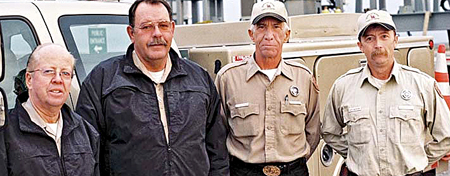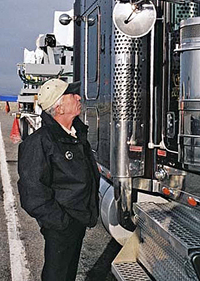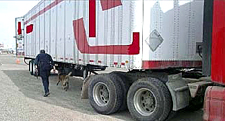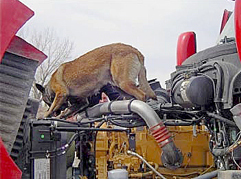
| CONNECTIONS |
IDAHO
ITD
HOME
511 TRAVEL SERVICES
IDAHO
DMV
ITD
NEWS
HIGHWAY
SAFETY
IDAHO STATE POLICE
STATE OF IDAHO
NIATT
NATIONAL
AASHTO
AAMVA
AAA of IDAHO
FEDERAL HIGHWAYS
FEDERAL AVIATION
IDAHO STATE POLICE
NHTSA
NTSB
TRB
U.S. DOT
TRANSPORTER
Archives
Milestones
Comments
Idaho
Transportation
Department
Office of Communications
P.O. Box 7129
Boise, ID 83707
208.334.8005
Fax: 208.334.8563

Ports
of Entry:
Saving lives... it's all in a day's work
Port
of Entry inspectors save lives, highways, monitor public roads throughout
eastern Idaho

From
Six Bits, District 6 newsletter
He knew something was wrong. The odor was foul.
“It was the smell of rotten flesh,” Mark Stroschein, Port of Entry inspector, said. “I served in the military. You never forget that smell.”
Mark stood on the running board of a tractor-trailer rig from Canada talking with the driver, who had bypassed the port of entry in Dubois.
The trucker was cooperative, but he said he didn’t feel well.
Then it happened: The man lifted his tee shirt to reveal a large wound on his stomach oozing green and white infection.
Mark
jumped from the cab for Port of Entry Inspector Bob Jackson to take
a look.
Bob immediately called the Clark County Emergency Medical Technicians
(EMTs).
But the Canadian didn’t want to go to the hospital. He was trying to get back to Winnipeg, where he had insurance. He would sit in his truck “till he got better.”
“The ambulance came, but the man still insisted he was fine,” Mark said, “He was delirious and could hardly walk.”
Bob soon discovered that the man’s driver’s license was suspended.
“You’re not going anywhere,” Mark told the long-haul trucker.
 Joined
by Port of Entry Inspectors Mike Akers and Ron Lindsay, Mark and Bob
stayed with the middle-aged man while they contacted his company. A
representative in Manitoba said the company’s insurance plan covers
drivers when in America.
Joined
by Port of Entry Inspectors Mike Akers and Ron Lindsay, Mark and Bob
stayed with the middle-aged man while they contacted his company. A
representative in Manitoba said the company’s insurance plan covers
drivers when in America.
The trucker relented and the Clark County EMTs returned to whisk him to the Eastern Idaho Regional Medical Center (EIRMC) in Idaho Falls.
One of the EMTs was Sheriff Craig King, who said the portly man was treating himself topically with some kind of plant.
“He
had undergone an operation, and the incision became infected,”
the sheriff explains.
EMTs discovered that doctors in Canada had installed some type of reinforcing
mesh in the lining of his abdomen, which his body had rejected.
The
Job |
Mark and the three other inspectors serve as full-time “rovers,” monitoring truck traffic throughout District 6. Almost every day, they set up one or more temporary ports of entry at designated pull-out areas in the district’s nine counties.
Using signs, they specify a safe point on the roadway where trucks can pull out from the main flow of traffic and stop for assessment. The district has 70 such locations that function as temporary ports of entry.
Depending on the volume of traffic on the highway they choose to patrol, the four rovers work together or in two-man teams. On occasion, Port of Entry Inspectors Dave Nickel and Matt French join them.
Also, Idaho State Police (ISP) truck inspectors occasionally assist with truck inspections.
“We stop up to 10 by-passers a day,” Mark says. Rovers catch them in their pickups, which are equipped with flashing lights, sirens and external public address speakers. Inspectors generally issue $191 citations for failing to stop at the marked ports of entry.
 Inspectors
also may write tickets for other violations such as invalid credentials
or unsafe equipment.
Inspectors
also may write tickets for other violations such as invalid credentials
or unsafe equipment.
If a trucker’s paperwork is incomplete or if his load appears overweight or unsecured, rovers typically escort the rig back to the port of entry for further evaluation.
While the fine for bypassing a port of entry is $191, the fine for hauling excess weight can be 10 times that… even more. Dean Berggren, District 6 Port of Entry Area supervisor, says a truck that is grossly overweight can draw a fine of several thousand dollars.
The state assesses
steep charges for overweight loads because the road damage caused by
even a legally loaded tractor-trailer equals the amount of damage caused
by 9,000 cars and pickups. Trucks that are grossly overweight can cause
much more road damage.
Dean says under Idaho code, POE inspectors have special deputy status,
which authorizes them to stop truckers who bypass ITD ports.
Inspectors ensure that truckers obey state and federal transportation laws, including the Federal Motor Carrier Safety Regulations, Dean says. They weigh and inspect trucks for unsecured loads, broken frames, worn brakes, bald tires and faulty lights. They also check driver paperwork in case of a suspended driver’s license, lapsed registration or out-of-date logbook.
ISP inspectors conduct independent truck examinations called “commercial vehicle safety alliance” inspections, which the federal government sponsors to help test truck equipment such as brake components and pressure gauges.
“Our work protects motorists from unsafe or unqualified drivers and from faulty tractor-trailer equipment,” Dean says. “It also protects our highways from unnecessary damage and wear.”
The
Department |
The Port of Entry group has 11 inspectors, who monitor the thousands of trucks crisscrossing eastern Idaho each day.
At the district’s fixed port of entry at Sage Junction are Mike Hare, senior inspector; Devin Weaver; Sherril Weaver, not related; Dave Rolfson; Dave Nickel and Matt French. They process more than 2,000 trucks per day, which traverse Interstate 15 and Idaho 33.
The busiest time of year is spring and fall, when potato and grain trucks join the procession of rigs rolling past the scale counter at the port.
This bustling center of tractor-trailer parades is open 18 hours per day seven days a week, nearly every day of the year. Two-man roving teams are Mark and Bob (Rover Unit 1), Mike and Ron (Rover Unit 2), and Dave and Matt (Rover Unit 3). Dave and Matt rove part-time, Dean mentions.
These six rovers patrol all D-6 tax-supported roadways, whether city-,
county- or state-owned, Dean says. “This means our group monitors
not only main highways but also less conspicuous roads such as Yale-
Kilgore and Red roads in Clark and Fremont counties.”
Dean notes that District 6 has some of the highest levels of enforcement
activity of any district in the state.
The
Unexpected |
No one knows exactly what to expect in port-of-entry work, Bob says.
“When I asked one trucker for his logbook, he threw it at me.” Bob says. “He was on meth.” The trucker wanted to fight, Mark said. “I told Dave to call ISP immediately.”
 “We
are not armed,” Mark says. The police brought their German Shepherd,
which sniffed out drug paraphernalia in the air filter of the engine,
under a fender of the cab, and behind a false wall at the front of the
trailer.
“We
are not armed,” Mark says. The police brought their German Shepherd,
which sniffed out drug paraphernalia in the air filter of the engine,
under a fender of the cab, and behind a false wall at the front of the
trailer.
Among the items found were bottles of ephedrine and a crack-cocaine pipe.
“It’s easy to tell when drivers use drugs,” Mark says. “You can smell them in the cab.
“Ninety-nine percent of the truckers are professional drivers. It’s that one percent we worry about.
“If a violator steps into his sleeper birth where I can’t see him, I tell him I’m going to open his door and watch.”
Violations sometimes stem from honest mistakes.
A recent driver on U.S. 26 northeast of Idaho Falls apologized for missing the port of entry at Beaches Corner, saying he was on his cell phone with his wife and daughter in San Diego, who had been evacuated to a hotel on the beach because of wildfires.
“I was lenient with him,” Bob said.
And the Canadian?
The man with the serious infection survived. After treatment at EIRMC, he returned to Manitoba with another driver sent to collect the truck.
The
Bottom Line |
POE inspectors are glad they can help keep Idaho safe. “You don’t want your kids driving when impaired drivers are on the road,” Mark says.
- - - - -
Photos: Full-time port of entry rovers Ron Lindsay, Mike Akers, Mark Stroschein and Bob Jackson (top) stand in front of a rover pickup at the fixed port of entry in Sage Junction; Mark meets a long-hauler at port of entry (top right); an ISP trooper follows a police dog to the back of a trailer to inspect cargo (middle right) and wall paneling. (Photo courtesy of Dean Berggren); an ISP German Shepherd sniffs out drug paraphernalia in the air filter of the engine. The dog also found drugs under a fender of the cab (bottom left) and in the front of the trailer. (Photo courtesy of Dean Berggren)
Published 11-23-07